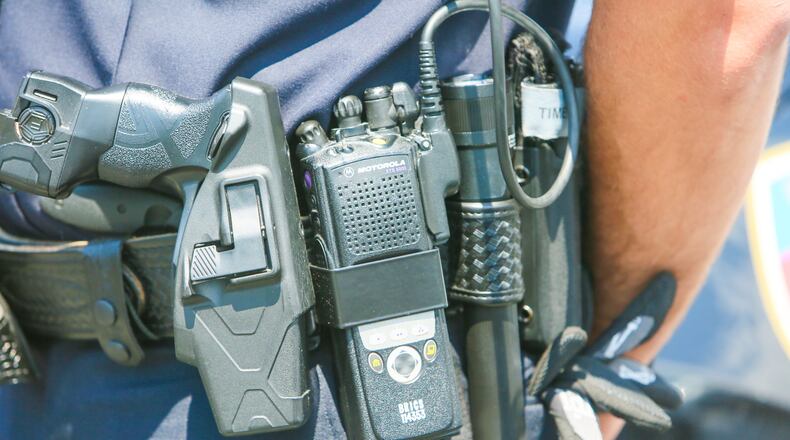Fairfield Twp. Fire Chief Tim Thomas said many of the smaller fire departments exist on “pancake breakfast budgets” and can’t even afford nominal replacement costs so the Association has been doing its due diligence.
RELATED: Butler County approves half-price deal for emergency communications system
“The bottom line is when you’re talking even a couple hundred dollars a radio that’s a significant impact, especially on some of these smaller departments,” Thomas said. “We’re just trying to make sure we’re buying what we need. It’s nice to have a Cadillac, but not all of us have the budget to buy a Cadillac, some of us have to buy Chevrolets.”
The county was able to negotiate a $10 million deal with Motorola for the new infrastructure system and half-price radios, even though they cut the total order down to 1,000. The county needed about 700 devises but ordered an additional 300 at the bargain price for the other jurisdictions.
Capt. Matt Franke said they were able to save about $100 per unit renegotiating the prices again, so law enforcement radios with holsters and microphones cost about $3,973, and devises for fire and medical personnel cost $4,064 because they need a different microphone. The prices include a $500 trade-in. The actual price the jurisdictions pay can vary depending on the accessories they buy, Franke said, but the base radio price is $3,683.
Rather than replace first responder radios in bulk, several Butler County safety agencies are testing a cheaper alternative to the Motorola equipment the county bought. Thomas said they have been testing other Motorola models and radios made by Kenwood.
The Kenwood base price — with no accessories like microphones and chargers — was $2,324 for one to 499 radios and $2,224 for 500 or more, according to Thomas.
The West Chester Twp. fire department had a Kenwood model in their hands for about two months. Assistant Fire Chief for Operations Steve Oughterson said the devise worked just fine with the county’s communication system.
“The Kenwood radios work,” Oughterson said. “We’re still looking at them, guys are forming their opinions on them. We haven’t met yet to say what our actual position is on it yet.”
Early on the township estimated it would cost about $1 million to replace all police and fire radios. At the county’s base price — accessories would be needed so the price would be higher — it would cost at least $751,332 to replace 204 radios. The Kenwood model, depending on how many communities might join a bulk purchase, would cost at least $453,696 to $474,096.
MORE: Officials balk at tax hike to replace emergency radio system
The trustees budgeted $135,000 to replace 31 radios for police and fire this year. Oughterson said he has 10 radios in his budget but he hasn’t placed the order yet.
Middletown Fire Chief Paul Lolli estimated for both fire and police divisions, if they bought new radios in bulk, it would cost about $1 million, money he says doesn’t need to be spent right now. He said the fire radios at least have another five to ten good years left.
“We want to make good financial decisions,” Lolli said. “For the city of Middletown division of fire and police we made the decision we don’t need to be in a hurry to purchase new radios entirely. So, we’re just taking a let’s wait and see approach and revisit it sometime in the near future.”
Miami University and New Miami are the only jurisdictions so far to fund a full replacement. Fairfield is in the approval process — still a couple ordinance readings to go before city council — of purchasing 12 radios for the police department at a cost of $51,332. City Manager Mark Wendling said the fire chief has indicated they don’t need replacements at this time.
At the outset Fairfield was the only jurisdiction that budgeted in advance of the county’s announcement the system upgrade was needed. Now retired Police Chief Mike Dickey said at the time they pencilled in $500,000 over two years in their capital budget for the replacement.
As the year since the announcement wore on, Dickey backed off a bit from needing the full replacement and Wendling said they revised the original plan.
“We’re not at a point where we’re going to be replacing everything…,” Wendling said. “They’re not broken for one, and we’re not really in a financial position to just go out and replace them all at once. But we are adding some as we need to.”
Franke said the county has about 250 radios left — not counting outstanding purchases like Fairfield — to sell. The county can return any radios they don’t sell to Motorola.
The commissioners back in 2005 put a 50-cent temporary sales tax to pay for the entire system and the 800 MHz system went into operation at the end of 2008. Several jurisdictions were under the impression when the county announced the needed upgrade last year replacement costs were included in the $1.5 million a year maintenance fees. These were paid for with the .25 sales tax that remained to support the system.
People have wondered how an almost $40 million communications system could be obsolete in a decade. Thomas said they need to start having discussions now to avoid the angst this issue has caused.
“Do we want to go through this again in 10 years, or 15 years when the radios need replaced again or should we be finding a permanent solution,” Thomas said. “Whether that’s looking at a funding mechanism so that when they’re due to be replaced again we’re not in the same pinch. How do you guarantee that you can do that and who is going to make that decision. Are we letting a vendor make decisions for us.”
About the Author
